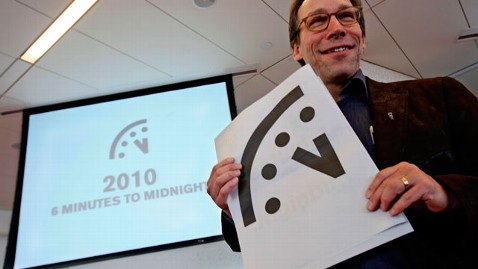'Doomsday Clock' a Minute Closer to the End

Image Credit: Mary Altaffer/AP Photo
Not to be confused with biblical prophecy or the Mayan calendar, the so-called Doomsday Clock owes its existence to scientists and engineers, or at least those who've been affiliated with the Bulletin of the Atomic Scientists.
The global security and public policy magazine has adjusted the minute hand on the clock 19 times since its inception in 1947, to "convey how close humanity is to catastrophic destruction." It was closest, according to the bulletin timeline - at 2 minutes to midnight - in 1953, when the United States "tested its first thermonuclear device, obliterating a Pacific Ocean islet in the process; nine months later, the Soviets test an H-bomb of their own."
Humanity was furthest away from doomsday, according to the bulletin - at 17 minutes to midnight - in 1991, after the Cold War officially ended. "The illusion that tens of thousands of nuclear weapons are a guarantor of national security has been stripped away," the bulletin declared.
Bulletin authors today nudged the clock a minute closer to midnight (5 minutes to midnight), after moving it a little further from the end of humanity in 2010. "Two years ago, it appeared that world leaders might address the truly global threats that we face. In many cases, that trend has not continued or been reversed," according to the bulletin website. "For that reason, the Bulletin of the Atomic Scientists is moving the clock hand one minute closer to midnight, back to its time in 2007."
Here's a sampling of other predictions in the 65-year history of the Doomsday Clock.
It's 7 minutes to midnight (1947): "As the Bulletin evolves from a newsletter into a magazine, the Clock appears on the cover for the first time. It symbolizes the urgency of the nuclear dangers that the magazine's founders - and the broader scientific community - are trying to convey to the public and political leaders around the world."
It's 12 minutes to midnight (1963): "After a decade of almost non-stop nuclear tests, the United States and Soviet Union sign the Partial Test Ban Treaty, which ends all atmospheric nuclear testing. While it does not outlaw underground testing, the treaty represents progress in at least slowing the arms race."
It's 9 minutes to midnight (1974): "South Asia gets the Bomb, as India tests its first nuclear device. And any gains in previous arms control agreements seem like a mirage. The United States and Soviet Union appear to be modernizing their nuclear forces, not reducing them."
It's 3 minutes to midnight (1984): The United States and Soviet Union had drifted miles apart by then. "Every channel of communications has been constricted or shut down; every form of contact has been attenuated or cut off. And arms control negotiations have been reduced to a species of propaganda," a concerned Bulletin informs readers.
It's 5 minutes to midnight (2007): "The world stands at the brink of a second nuclear age. The United States and Russia remain ready to stage a nuclear attack within minutes, North Korea conducts a nuclear test, and many in the international community worry that Iran plans to acquire the Bomb. Climate change also presents a dire challenge to humanity. Damage to ecosystems is already taking place; flooding, destructive storms, increased drought, and polar ice melt are causing loss of life and property."